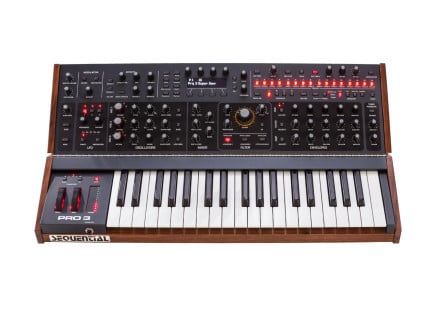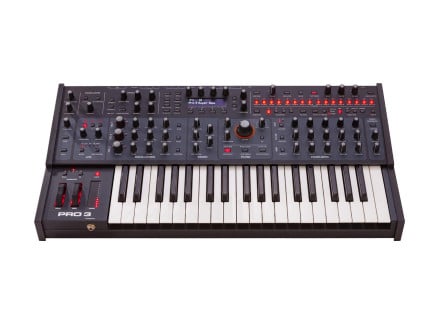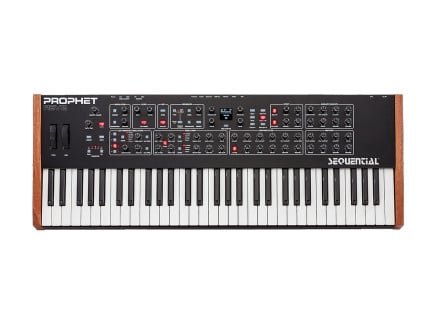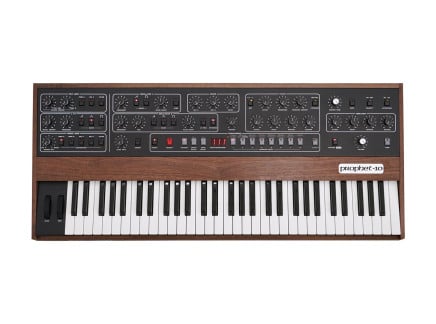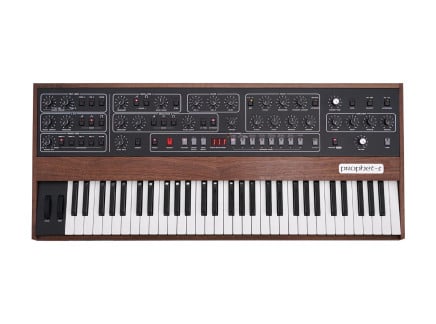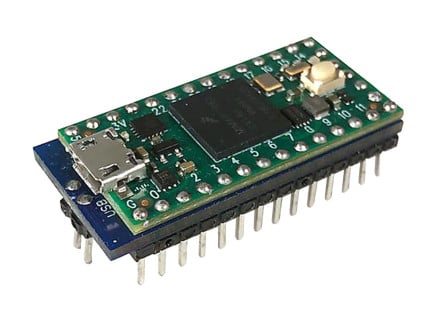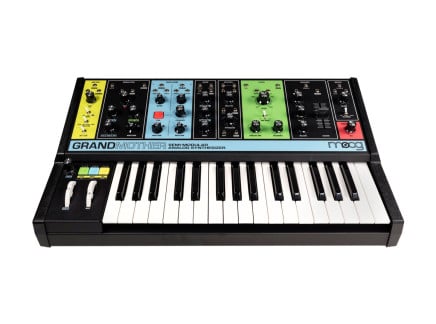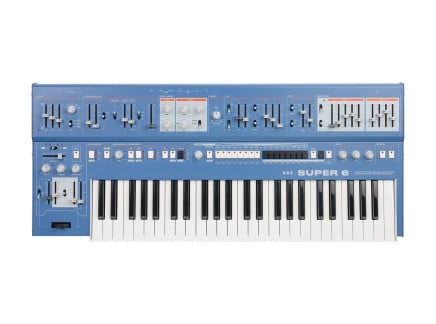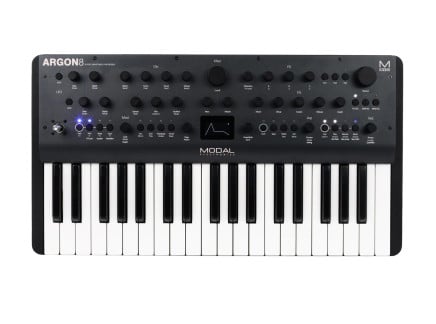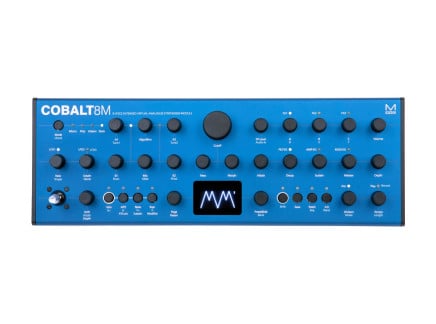It's been quite a year—but despite everything, 2020 has been a remarkably interesting year for the world of synthesizers. More than ever before, we've seen a surprising confluence of vastly different designs. A few years ago, a "best synths" list would've contained a handful of virtual analog synths, possibly some rudiementary analog monosynths, and maybe, just maybe some new company dipping their toes into desktop semi-modular design. This year, though, we've got a little bit of everything, and all with astonishingly high quality.
So what were the best synths of 2020? In our opinion, the Sequential Prophets and Pro-3, Modal Cobalt8, Korg Opsix, Buchla Easel Command, Erica SYNTRX, Moog Subharmonicon, UDO Super 6, and Dreadbox Typhon check all the boxes. And while there are plenty of other spectacular instruments out there, each of these are outstanding offerings in their own niche—the best-in-class for their respective price points and overall approach to instrument design and user interaction. So what makes them all so special?
Best Sequential Monosynth...Ever? The Pro-3
Perhaps our top pick from NAMM 2020, Sequential announced the Pro-3 earlier in the year, back when we were still able to go to concerts and clubs, remember those? Well definitely don’t forget about this powerhouse of a synth: the Pro-3 is arguably one of the most powerful and flexible mono-synths ever made, featuring three of everything. Three filters, from the OB6, and Prophet-6, and a Moog-inspired ladder filter, three highly configurable LFOs, three dedicated envelopes, three oscillators, and optional paraphony to play up to three notes! Nearly any sound from the last few decades of synthesizers is at the tip of your fingertips when it comes to the Pro-3—it's a sound designer's dream, and proof that Dave Smith still has the chops to turn the music industry upside down 40 years later.
The Pro-3 is absolutely loaded with features, combining the power and tone of vintage inspired analog with the untapped potential of digital control and routing. The short list of favorites includes the two fully analog oscillators, paired with one highly capable digital oscillator with wavetable functionality (and even user wavetable support!), a 16-track, 64-step sequencer that boasts ratcheting, parameter locking and automation, and an astonishing 32 slot modulation matrix that can route signals to and from the Pro-3's four CV ins and outs, making it a capable interface for your Eurorack modular or other CV-capable synthesizers.
Given the flexibility of its modulation options, stellar keyboard and sequencer, and its extensive I/O, the Pro-3 might just be one of the most interesting and powerful monosynths of all time...to the point that simply calling it a "monosynth" feels tremendously misleading. If you want something that can produce airly leads, grimy bass lines, industrial rhythmic textures, and out-of-this world atmospheres, this unassuming synth can truly handle it all.
Return of a Classic: Prophet-5 & 10
Of course, 2020 also saw the rebirth of one the most iconic and sought after synthesizers of all time; the Prophet-5. Sequential's legendary programmable polyphonic synthesizer was one of the first of its kind, offering extensive control and recallable presets. At the original time of release in the late 70s, this was an incredible achievement, and it went on to reshape the entire landscape of the music technology industry. Many people go so far as to label the Prophet-5 the first "modern" synthesizer, and with its track record of being used by artists from Tangerine Dream to Dr. Dre, it's a fair title.
The reissued Prophet-5 is nothing short of amazing, sporting authentic Curtis oscillators and a newly designed 2140 chip from Dave Rossum, the original designer of the famous SSM 2040 filter chips that gave the original Prophets their lush and vibrant character. Original Prophet-5s came in three revisions, each unique in their own right featuring different chipsets and a different sound: and the reissued units add a “Rev” switch that allows you to change between the character of these revisions on the fly, in addition to a “vintage” knob which relaxes the accuracy of the circuits and allows more organic and random elements to spill over for an authentic vintage sound that you can dial in to suit your needs.
The front panel layout of the Prophet-5 remains largely unchanged from its vintage counterpart, and that's probably because there's very little that could possibly be improved. The Prophet-5's simple and intuitive layout is what made it a runaway success in the late 70s and early 80s, and what inspired scores of musicians and performers to create their own unique sounds. The simplicity of the Prophet-5 is part of its beauty: it's nearly effortless to program, every parameter has its own dedicated knob, and it even includes the original 40 presets, as well as 200 new sounds, and 200 slots for your own creations.
Dave and the crew at Sequential didn’t miss the chance to refine a few things that the original lacked, however, adding velocity sensitivity, aftertouch, MIDI connectivity both DIN and USB, and the addition of a more extensively programmable unison mode, which now works with glide. All that synth packed into a jaw-dropping black Walnut body with a semi-weighted Fatar keybed makes the Prophet just as aesthetically pleasing and inviting to performers today as it was back in 1978. And let’s not forget the option to choose between a five-voice model, or the glorious Prophet-10, with 10 voices of polyphony. Both versions of the Prophet-5 are poised for what looks like another many decades of inspiration and analog warmth, and we couldn't be more happy to see these amazing instruments become more accessible to musicians and performers the world over.
West Coast Classic Reimagined: Buchla Easel Command
The Buchla Music Easel is a cult classic instrument—famous for its idiosyncratic workflow, unique sound, its colorful design and touch plate keyboard, and its overall embrace of the experimental. Originally designed in the early/mid-1970s and produced in only very limited quantities, the Music Easel was a combination of two specific modules, the 208 Stored Program Sound Source and 218 Touch Activated Voltage Source: its voice and keyboard sections, respectively. It eventually fell into obscurity, forgotten by many—but its re-release in 2013 by Buchla Electronic Musical Instruments brought the sound of this peculiar semi-modular instrument to a broader audience than ever before, with musicians like Todd Barton and Kaitlyn Aurelia Smith exploring its peculiar sonic possibilities.
In late 2019, Buchla USA announced a new version of the Easel's voice module, the 208, to be released in its own standalone enclosure: the Easel Command. This version expands the capabilities of the original 208 in a number of ways, from a revised layout and simple quality-of-life improvements to entirely new features, as well as the ability to connect to virtually any gear in the rest of your studio. Designed to make it easier than ever to bring the Buchla sound and experience into any setup, the Easel Command is perhaps one of the company's best-thought-out designs, and certainly their most affordable complete instrument to date.
The Easel Command embodies all of the core principles of what is now commonly referred to as "West Coast" synthesis—an esoteric approach to synthesis and instrument design borne from the work of Buchla himself. While we've seen a pretty huge surge of interest in these approaches the last several years, especially with the growth of popularity in Eurorack, the Buchla 208 is the real deal: one of the first implementations of several now-popular synthesis concepts. Feauting a complex oscillator with waveshaper/wavefolder, several options for internal audio-rate modulation (FM, AM, and ring modulation), two lowpass gates, and a complex array of unique modulation sources, the Easel Command is everything you could want from a "West Coast" synth...with a timeless design that makes inspiration easy to find through simple exploratory play.
The Easel Command's signal path is particularly interesting: while its audio path is more or less fixed, its CV signal routing is completely open-ended. Using a matrix of color-coded jacks toward the bottom of the instrument, you can connect any of its CV sources to any modulation destination—meaning that you can create an astonishing number of ways to interact with the instrument, and even to make it play itself. Between the built-in five-step sequencer, quad random voltage source, looping AR/AHD envelope, the "pulser" clock/LFO/envelope, modulation oscillator, envelope follower, and voltage inverter, you can explore a wide range of control possibilities. And of course, one of the most important aspects of the Easel Command is its connectivity: it features MIDI input via 5-pin DIN and USB, and even features 3.5mm CV and gate inputs so that you can easily integrate it with your favorite Eurorack or standalone CV controller. It even offers USB-A MIDI host capability via an optional expansion, making it easy to attach any MIDI controller directly to the Easel Command, even without the use of standard DIN cables.
Not enough can be said about the Music Easel: it's a fascinating instrument that provides an astonishing sonic range in an unassumingly simple and directly usable package. Best of all, it's simply fun and inspiring to use—and in this newest iteration, it's capable of far more than any of its predecessors. If you're looking for a deep dive directly into "West Coast" synthesis with a healthy dose of musical surprise and unexpected inspiration, then the Easel Command is simply the best thing you can get.
A Matrix of Surprises: Erica SYNTRX
Syntrx from Erica Synths takes the legacy of the classic EMS Synthi and runs with it—and it runs with it a long way. It is hardly a clone, but uses the form factor and pin matrix interface that made the Synthi such a well-loved synthesizer. Instead of physical pins, the digitally controlled 256-point pin matrix uses an etch-a-sketch X/Y knob interface to make the connections. Connect up to 16 outputs to a single input destination, or 16 outputs from a single source, with no signal loss, and save and recall pin connections using the preset management system. However, Syntrx does not save knob positions. This means a patch may end up wildly different every time you recall it, depending on the current panel settings. A common theme seen throughout the Syntrx, the inputs lack CV attenuators, but the outputs of the individual modules have their own level attenuators. When taking a single source to multiple destinations, this offers a way of making macro changes from a single knob movement.
The three oscillators feature a wide frequency range and multi-turn potentiometers to precisely tune them. Each oscillator features a waveshaping circuit to change the character of the waveforms. This includes sine shaping, sawtooth/triangle skew, and pulse width control. Sync oscillator two to oscillator one, or leave it free running. Syntrx mixes the two waveforms from oscillator one and two before running into the pin matrix, with amplitudes set by the two level controls. By mixing together these different waveshapes, more complex waveforms arise from simple building blocks. Control the oscillators' pitch via MIDI or with the two CV inputs on the rear of the Syntrx. Oscillator three also functions as an LFO, running down into the range of 0.05Hz.
Syntrx features a Zener diode-based noise generator with full-spectrum white noise. Emphasize different frequency ranges using the colour knob, from low-frequency pink or red noise to high-frequency blue noise. The noise runs into the sample & hold section, along with the triangle/sawtooth waveform from oscillator three. The sample & hold features an independent rate control that runs into low audio rate. Create stepped random voltages or a stair-stepped version of the oscillator three output. Due to the pin matrix's space constraints, the triangle/sawtooth waveform and sample & hold outputs share an output pin. Use the switch to select just the S&H output, only the oscillator three waveform, or a complex mix of the two.
One of the unique features of the Synthi was its trapezoid envelope generator, which the Syntrx retains. This specialized looping envelope generator takes the form of a trapezoid with controls for attack, on, decay, and off. All stages feature a manual control, and the decay section features a CV input for dynamically varying the decay time. Fire off this envelope using the attack button next to the joystick, external gate signal, or MIDI note-on messages. Trapezoid also controls the level of the built-in VCA, which is pre-wired and requires no connection. The joystick is a four-axis joystick with built-in attenuators to set the voltage range. This is a great way to add gestural control, particularly if sent to a few different destinations.
The filter is a diode-ladder filter with lots of character. At high resonance settings, it begins to oscillate, particularly with low or no input signals. However, the filter will not track 1V/oct, but it keeps up with an incoming CV signal up into audio rates. The output stages each feature a tilt filter. In the middle of the control, the response is flat. Turning to the left emphasizes low frequencies, and to the right emphasizes high frequencies. Create metallic and bell-like tones using the ring modulator. This four-quadrant multiplier multiplies two signals to create new harmonics and overtones based on the two input signals' relationship. Hook up a microphone to the audio input and make out of this world robot voices. Bring two external audio sources into the synthesizer with an adjustable switch for line level or mic level input gain. A real spring reverb adds depth and space to the Syntrx. Turning up the feedback all the way may cause it to grow out of control, so fine-tuning that control is necessary. Since it is a physical spring, tapping or shaking the case will also excite the spring, creating wild and sometimes unpredictable effects. The spring may also pick up the built-in speakers, so adjust those as needed.
The Syntrx represents a step forward for the form factor of the Synthi and other similar synthesizers. The internal digitally-controlled pin matrix provides an easy way to save and recall presets, something not typically found on a modular synthesizer. Fuss no more with complicated patches and cables; Syntrx stores all connections in internal memory. The one trade-off is the lack of connectivity with other modular synthesizers. With only pitch CV and gate inputs, it is not something I would recommend to someone looking to expand a larger Eurorack system. However, as a standalone instrument, it works fantastically, producing a wide range of sounds and behaviors that are unique to it.
Semi-Modular Experimental Playground: Moog Subharmonicon
Originally introduced as a workshop instrument at Moog Fest 2018, the Subharmonicon got a finalized release in 2020. It retains the form-factor of the Mother-32 and DFAM but goes into unpredictable places. It is a synthesizer based around subharmonics, or divisions of a base frequency. These subdivisions come in two forms, sonic and rhythmic, which play out in different ways within the synthesizer.
The design and influences that went into the Subharmonicon reach far past the modular synthesizers of the 1960s. Freidrich Trautwein set the groundwork for the Trautonium, an early tube-based subtractive synthesizer with a resonant filter. Oskar Sala took over this project, later renaming it to the Mixtur-Trautonium. He went on to add a series of subharmonic generators that generated undertones, or divisions of the master frequency. Around the same time, Henry Cowell, Joseph Schillinger, and Leon Theremin collaborated on the Rhythmicon. This instrument incorporated sixteen polyrhythmic generators to create complex rhythms by combining signals at integer-related durations. Moog took inspiration from both these sources, updating these theories and practices for the modern age.
The oscillator section features two primary oscillators, each with two sub-oscillators. The primary oscillators set the overall frequency for that section. Each of the two sub-oscillators features a subdivision control of this master frequency. This divides the master pitch by an integer between 1 and 16. Each VCO features three selectable waveshapes, square, sawtooth, and a special third waveshape. In this third mode, the primary VCO outputs a square wave, and sub-oscillator one is normalled into the primary oscillator's pulse width modulation. This mode is a unique implementation of PWM that is sure to create some far-out tones. Each oscillator and sub-oscillator features an individual level control, useful for bringing in and out individual voices. The mixer begins to distort the oscillators slightly when turned up into the upper reaches of the controls.
Additionally, the oscillators feature five different quantization options: unquantized, 12-tone equal temperament, eight-tone equal temperament, 12-tone just intonation, or eight-tone just intonation. With equal temperament, the notes in a scale divide an octave into 12 equally spaced notes or semitones. This is the most common way to divide an octave, usually seen throughout Western music theory. On the other hand, just intonation uses whole number ratios of a base frequency. This system provides what some might call a convention that is more in tune due to the whole number ratios between the notes. Equal temperament sacrifices equal divisions between notes to create a system that more easily transposes between scales. Due to just intonation's method of deriving a scale from a base frequency, transposing or modulating a just intonation sequence will knock everything out of tune.
Moog included two sequencers to modulate the pitch of both oscillator sections. While they may seem simple, two four-step sequencers with the addition of polyrhythmic clocking unlocks new sequencing possibilities. The two sequencers are independent of each other, with sequencer one modulating VCO one and respective sub-oscillators, and sequencer two modulating VCO two and respective sub-oscillators. The sequencers get their clock information from the four polyrhythmic generators. These polyrhythmic generators are clock dividers that divide the tempo clock rate by integers from one to 16 divisions of that master clock speed. So if the rhythm generator has a division of four, it takes four clock pulses from the master tempo before a pulse from the divider. Any one of the four rhythm generators is assignable to either sequencer. Not only can you clock a sequencer from one division, but multiple divisions can be combined for more complex sequences that transform into sequences that sound much longer than four steps.
The filter is a classic Moog 24dB/oct low pass filter, with the same much-loved character found on other Moog synthesizers. Moog never misses the mark with their filters; it's such a classic aspect of their sound that has cemented the Moog name in the collective consciousness. The filter begins to self oscillate at high resonance settings, adding a seventh sound source into the mix. All six oscillators run into a single filter after the mixer section, making the Subharmonicon a paraphonic synthesizer instead of a polyphonic one. A linked pair of envelope generators modulate the VCF and the VCA. While they have separate controls for attack and decay, they share a common trigger/gate input. Since it has a single volume envelope, the Subharmonincon plays a single volume rhythm: the total of all active polyrhythms, while the oscillator's pitch changes based on their assigned polyrhythmic divisions.
The Subharmonincon is semi-modular, meaning it doesn't need any patch cables in order to make sound. However, the patch bay opens up new possibilities for inter-module patching and integrating the Subharmonicon with a larger modular or semi-modular system. It pairs nicely with the Mother-32 and DFAM, complimenting their feature sets while providing new synthesis methods. Instead of retreading old ways of seeing synthesis, the Subharmonicon is a step in an altogether different path. It brings together concepts from before Moog even existed with modern implementations for a fun and exciting instrument from Moog.
Affordable Powerhouse: Dreadbox Typhon
Greek synth designers Dreadbox are quickly ascending to the highest ranks of contemporary electronic instrument makers. Their standalone instruments like Nyx and Erebus have earned special acclaim for their vibrant analog character, and their colorful Chromatic series of Eurorack modules pack clever features while remaining fairly affordable to both beginner and veteran patchers alike. Back in July, they unveiled Typhon, their latest and most compact analog instrument to date.
When Typhon was announced, plenty of musicians were instantly drawn towards this little analog box of fun. In terms of sound, it contains a monophonic subtractive synth voice, boasting the tried-and-true Dreadbox vibes, and making it a great choice for basses, drones, and leads. Speaking of vibes, it also contains a digital effects engine designed by Sinevibes, with chorus, delays, distortion, reverbs, and more for sculpting punchy in-your-face sounds or subdued soundscapes. Through the use of its screen and interface of buttons, sliders, and a single encoder, a 32-step sequencer and 3 digital modulation sources can be freely routed to many parameters of the analog audio circuit. This combination of analog sound with digital control is the key to packing so much versatility and power into this small package.
While compact electronic instruments aren't new, Typhon is able to be fully powered via USB, so using it in tandem with a USB power bank makes it an instrument that can go nearly anywhere. Dreadbox has already put out some superb firmware updates since Typhon came out earlier this year. Additional effect algorithms, sequencer enhancements, and MIDI improvements have boosted the capabilities of this otherwise unassuming little box. This makes it an excellent member of the studio, but it's a stellar companion to keep around in a backpack, ready to go whenever inspiration strikes.
Swirling Stereo Future Classic: UDO Super 6
Ever since the Super 6 was revealed back at Superbooth 2019, the synthesizer world has been buzzing with anticipation for this hybrid instrument melding analog and digital philosophies. Finally, after continued months of development, UDO began shipping the Super 6 just a few months ago, and despite the long wait it seems to be living up to the hype. With its own unique twists on synthesizer architecture, and a stellar palette of sounds to back it up, the Super 6 was an immediate contender for this recap article.
Although visually it might harken back to Roland's Juno and Jupiter instruments of the early 1980s, the Super 6 is a thoroughly modern instrument. At its core are two digital oscillators implementing what UDO calls "Direct Digital Synthesis" (DDS). These oscillators, based upon FPGA technology, are running at much higher sample rates than traditional audio processors, and in doing so are able to maintain natural sounding FM, ultra-precise phase, and practically nonexistent aliasing across the full audio range. One oscillator employs the use of a bank of 16 stored waveforms, and the other relies solely upon traditional analog-style waveforms, with a clever implementation of keyboard-tracked crossfading between the two oscillators.
Additionally, while most synthesizers maintain a mono signal path until the final mixer or effects section, the Super 6 is fully stereo from start to finish, including the analog filters and VCAs. In fact, the Super 6 implements a Binaural mode where its 12 voices are condensed down into six pairs of "Super" voices (hence the name Super 6), assigning six full synth voices each to the left and right output channels. For further immersive stereo fun, the LFO offers modulation over the phase relationship between the left and right sides, making it easy to dial in deep, swirling panning effects. This is magnified further upon activation of the onboard chorus and delay effects, resulting in incredibly lush pads and textures without much effort.
While the Super 6's analog components are set in stone, UDO is still hard at work fleshing out additional features to be implemented via future firmware updates. This includes some basic functions like USB MIDI and real time transmission of control changes, but most notably the Super 6 will soon support MPE. With a compatible controller, the joys of polyphonic aftertouch, expression, and pitch bend messages will be able to be sent into the Super 6 to add further expressive control to an already evocative and beautiful instrument. UDO will also be putting out some supplemental waveforms that can be loaded into the DDS oscillators, thus expanding the raw sound capabilities of the Super 6 even further. At any rate, we're excited to see the Super 6 out in the world, and we're excited to see where UDO and this synthesizer will go from here.
FM Synthesis Reimagined: Korg Opsix
Korg's recently announced Opsix is not out quite yet, but we can confidently say that it is one of the most exciting synth announcements of the passing year. Anything that makes FM synthesis more approachable and easier to navigate is always welcome in the synth world, and Opsix certainly accomplishes that. However Korg went even further, and designed an instrument that seamlessly combines several powerful sound shaping algorithms which significantly expand the traditional FM palette.
As the name suggests, the core of Opsix comprises six operators that are easily controlled via dedicated sliders and knobs for level and tuning/ratio adjustments. Interestingly, unlike the strictly sine wave operators found in conventional FM synths, the operators on Opsix provide a more diverse selection of waveforms. The differences with traditional FM synthesis do not stop there. While the main method of timbral sculpting in the traditional FM is achieved by operators modulating the frequency of one another in various configurations, Opsix allows each of its six operators to be modified through either FM, ring mod, filter, filter FM, and wave folding—this is what Korg calls "altered FM synthesis." This allows you to create sounds that are incredibly rich and complex using the six operators alone, but of course there is still more to the story.
Filters are commonly considered to be the essence of a synth's character, and Opsix doesn't come short here either. The synthesizer is equipped with eleven models including the classic MS-20 and Polysix filters. Filter is applied per voice, and given the beastly 48-voice polyphonic architecture of the synth, it is clear that the Opsix would be a great choice for lush harmonic pads and complex clusters. Three quality multi-effects are also added to spice up the sound even further. In terms of control, the synthesizer is endowed with a powerful polyphonic 16-step sequencer, an arpeggiator, three LFOs with a wide selection of waveforms, an envelope generator per operator, and three additional envelopes for parameter modulation on top of that. With such a large amount of features, it may seem difficult to find the right place to start a new patch—but worry not, as Korg integrated a flexible randomization feature into Opsix that can be used either to randomize the position of specific parameters or the whole preset.
Overall, Opsix presents a much welcome new take on FM synthesis, and its clever design not only renders it as a powerful tool to be added into the arsenal of seasoned synthesists, but also makes it an inspiring and accessible electronic instrument for those who are just starting out.
Modern Virtual Analog: Modal Cobalt8
For anyone with a hand on a pulse of the synth industry, it is not a secret that digital synthesizers have been on the rise lately. In the last year alone the world has seen the releases of several game changing digital synths including ASM Hydrasynth, UDO Super 6, Waldorf Iridium, and Modal's own Argon8. While we all love analog synthesizers for their warmth and character, it is difficult to deny how increasingly powerful digital technology makes the new landscape of sound synthesis wildly exciting. Soon to be released, the 8-voice polyphonic Cobalt8 is yet another testimony to this with a sonic flavor that manages to blur the line between the digital and analog.
On the surface, aside from its inviting blue color, Cobalt8 looks almost indistinguishable from its slightly older sibling Argon8, but of course the two synthesizers are completely different, and rather than overlapping in sound and functionality, they only complement each other. Unlike Argon8, Cobalt8's main oscillators are not wavetable-based, but instead they are what Modal calls "extended virtual analog" models. There are two oscillator groups, each featuring thirty four distinct algorithms with their own unique timbral structures and set of parameters. The oscillators also feature controls of the drift and voice width, which makes it very easy to dial in thick stereo pads. The other source of Cobalt8's character is an incredibly well-designed DSP model of a classic ladder filter. To top this off, the synthesizer also boasts a fantastic selection of effects, ranging from intricate delays, lush reverbs, mind-bending flangers, phasers, choruses, and much more.
In terms of modulation, Cobalt8 features three envelope generators for amplitude, filter cutoff, and assignable modulation. There are three LFOs, two of which are polyphonic and one is global. For more manual modulation, the synth features a 4-axis joystick that can be assigned to control a wide set of parameters. Speaking of modulation assignments, the section is truly brought to life with a powerful mod matrix that includes 12 modulation sources and 55 destinations.
Besides the high-quality Fatar keyboard, Cobalt8 also comes equipped with a robust polyphonic 64-step sequencer, which can stack up to 8 notes per step, as well as a comprehensive 32-step arpeggiator with programmable rests. And as a truly modern synthesizer, Cobalt8 is MPE compatible, which opens up the possibilities for extremely expressive performance.
Just like Argon8, Cobalt8 comes in three variations—Cobalt8 (37-note keyboard), the extended Cobalt8X (61-note keyboard), and the most portable Cobalt8M (desktop version). Whichever version fits your workflow best, if you are looking to expand your current synth collection with a new flavorful instrument or even choose the first hardware synth for your studio, Modal's Cobalt8 may just be it.
Truly, 2020 has been a wild year for synth development: new-school virtual analog, reimagined FM synths, the return of the Prophet-5, a reinvented Synthi, and an updated Buchla Music Easel...and so many others. Synth designers are each honing in on their own niches and producing some truly astounding results...so no matter what your musical interests, no matter your performance style, there's likely to be something out there that you'll find compelling and inspirational. In the world of electronic instrument design, it's a truly exciting time.


